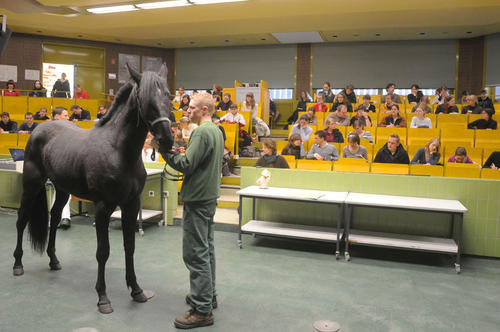Smart Transplants
Veterinary medicine researchers at Freie Universität develop new approach to treating osteoarthritis in dogs and horses
Aug 18, 2011
Help for horses with osteoarthritis: Smart transplants help the cartilage to regenerate itself.
Image Credit: David Ausserhofer
Swollen or stiff joints, foundering, cringing upon contact – in dogs or horses, these symptoms point to a widespread and very painful disease: osteoarthritis. It is a sad diagnosis for animals and their owners, since the joint disease has historically been very difficult to treat, with no prospect of full recovery. Now a treatment method developed by veterinary medicine researchers at Freie Universität offers hope for helping dogs and horses suffering from osteoarthritis.
Before now, the only things that helped osteoarthritis patients – animals and humans alike – were anti-inflammatory drugs, such as cortisone, and pain medications. And all they could do was ameliorate the symptoms. The team of researchers under Professor Michael F. G. Schmidt, head of the Institute of Immunology and Molecular Biology at Freie Universität Berlin, however, is focusing on “smart transplants” to counteract the chronic inflammation and progressive loss of cartilage suffered in this disease.
The transplants help the cartilage to regenerate. To accomplish this, the scientists take healthy cartilage cells from the affected joint in the same patient and multiply them in a cell culture lab. Then the cells are equipped with an innovative genetic construct, a structure made up of various genes. Packed together into transplants, the cells can be used in the affected joint following this conditioning step. “This method is already practiced in a similar form in human medicine, where it is used to treat joint defects in the early stages, but it has not been effective so far in arthritis, an advanced form of joint disease,” explains doctoral student Annemarie Lang.
This is where the veterinary medicine researchers’ work comes in. The smart transplants physically bolster the defective cartilage, so inflammation is blocked and pain is alleviated – even during advanced stages of the disease. The major difference between this method and the one previously used for early-stage joint defects: the transplants are “smart,” which means they “think” and adapt. As long as the joint is inflamed, they form proteins with a therapeutic effect, but as soon as the inflammation subsides, production of the proteins stops. This prevents adverse side effects such as hypersensitivity and allergic reactions.
Lang has been studying veterinary medicine since 2006 and has been participating in the research project for a year. As part of her studies toward the doctorate, Lang is studying how the smart transplants could be used in horses. “This project offers the opportunity to build a bridge between veterinary medicine and human medicine,” Lang says, continuing, “The joints of horses are definitely comparable to human joints. If our treatment method proves effective in horses, there will be nothing standing in the way of studies of this approach in people.”
Schmidt is already getting ready for the next project: He and his team aim to find out whether it is possible to use connective tissue stem cells instead of the patient’s own cartilage cells in the smart transplants. That would eliminate the need to take healthy cartilage cells from the joint, so the only surgical intervention necessary would be the transplant operation itself.
Further Information
Prof. Dr. Michael F. G. Schmidt, Department of Veterinary Medicine, Freie Universität Berlin, Institute of Immunology and Molecular Biology, Tel.: +49 (0)30 2093-6468, Email: schmidt.mfg@vetmed.fu-berlin.de

